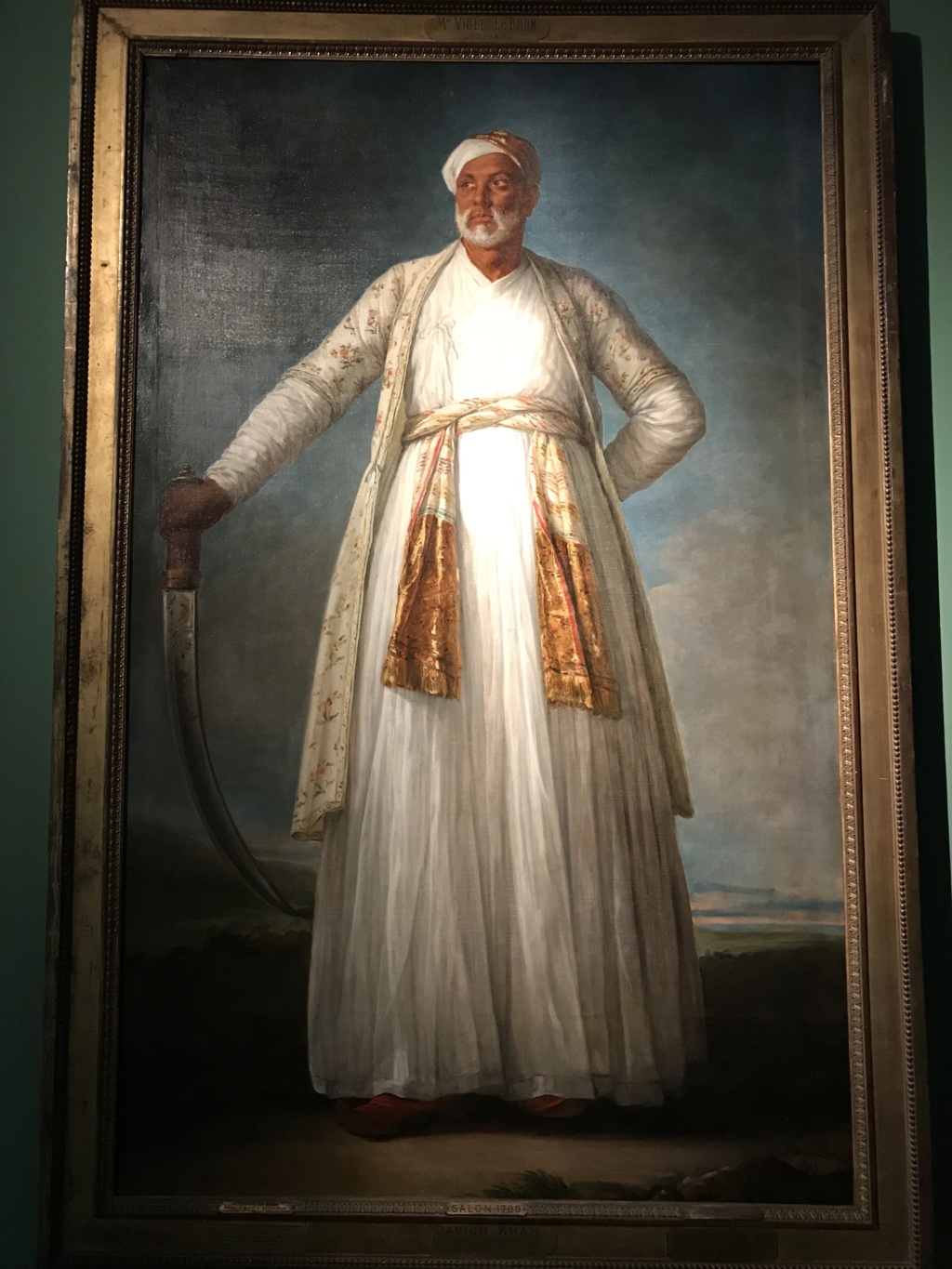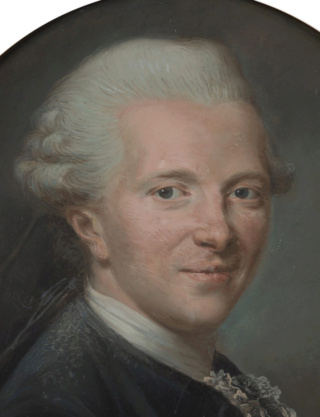Galerie virtuelle des oeuvres de Mme Vigée Le Brun
+16
Duc d'Ostrogothie
Marquis de Bombelles
Trianon
JAGdelile
CLIOXVIII
fleurdelys
Vicq d Azir
MARIE ANTOINETTE
La nuit, la neige
Lucius
Gouverneur Morris
Comtesse Diane
Mousseline
Comte d'Hézècques
Mr de Talaru
Mme de Sabran
20 participants
LE FORUM DE MARIE-ANTOINETTE :: La France et le Monde au XVIIIe siècle :: Les Arts et l'artisanat au XVIIIe siècle :: Les arts graphiques et la sculpture
Page 14 sur 15
Page 14 sur 15 •  1 ... 8 ... 13, 14, 15
1 ... 8 ... 13, 14, 15 
 Re: Galerie virtuelle des oeuvres de Mme Vigée Le Brun
Re: Galerie virtuelle des oeuvres de Mme Vigée Le Brun
Nous avions annoncé la vente aux enchères de ce portrait dans notre sujet consacré à :
 L'ambassade de Tippoo Sahib (Tipû Sâhib) à Versailles
L'ambassade de Tippoo Sahib (Tipû Sâhib) à Versailles
Le portrait de Muhammad Dervish Khan, par Elisabeth Vigée Le Brun, s'est envolé ce 30 janvier pour 7,2 millions de dollars.
Record mondial pour l'artiste, et record mondial pour une oeuvre peinte par une femme (période pré-moderne).
Elisabeth-Louise Vigée Le Brun
PORTRAIT OF MUHAMMAD DERVISH KHAN, FULL-LENGTH, HOLDING HIS SWORD IN A LANDSCAPE
Signed and dated lower right: L. Vigée Le Brun / 1788
oil on canvas / 88 3/4 by 55 1/2 in.; 225.5 by 136 cm.

Photo : Sotheby's
Si le sujet vous intéresse, je vous recommande la lecture de la note au catalogue publiée par Sotheby's (en anglais).
Vous y retrouverez raconté l'histoire de cette ambassade et celle de ce tableau.
 C'est ici : The volatile saga behind Elisabeth Louise Vigée Le Brun portrait of indias ambassadors to France
C'est ici : The volatile saga behind Elisabeth Louise Vigée Le Brun portrait of indias ambassadors to France
Extraits de la note au catalogue :
This imposing and potent portrait by Elisabeth-Louise Vigée Le Brun depicts Muhammad Dervish Khan, the Indian ambassador sent to France by the powerful Mysore ruler Tipu Sultan.
Painted in the summer of 1788 and exhibited at the Salon of 1789, when political unrest had begun to boil in France, the work is an evocative account of France’s fascination with the East as well as Vigée’s resourcefulness in acquiring this unique commission.
It is obvious that both Dervish Khan and Vigée would have found each other equally exotic and endlessly fascinating: one, a powerful Indian man parading around Paris in elegant muslin and gold-embroidered costumes, the other a woman artist who held such sway that she could get the King of France to request the sitting.
(...)
As Muslim men, the idea of having themselves represented pictorially, let alone by a female artist, was unheard of.
Vigée tenacity and resourcefulness in achieving the sitting was a remarkable feat. After the request came from the King, they agreed to sit for her at their hôtel in Paris.
Her detailed description of the encounter in her memoirs provides a fascinating look into this awkward clash of cultures. She is thrown by their sprinkling of rosewater on her hands upon her entering, and later at dinner is shocked when she finds the dining room set for them to sit down on the floor.
She painted Dervish Khan first, “standing, with his hand on his dagger. He threw himself into such an easy, natural position of his own accord that I did not make him change it.”

Photo : Sotheby's
When the paintings had finished drying, Vigée sent for the works but was refused; Dervish Khan had hidden his portrait behind the bed.
As Vigée enthusiastically recalls, she strategically convinced his servant to steal it back for her, only to later hear that Dervish Khan had then planned to murder the servant for this transgression.
Luckily, an interpreter convinced the ambassador that murdering your valet was not acceptable practice in France, and he falsely claimed that it was the King who wanted the portrait.
(...)
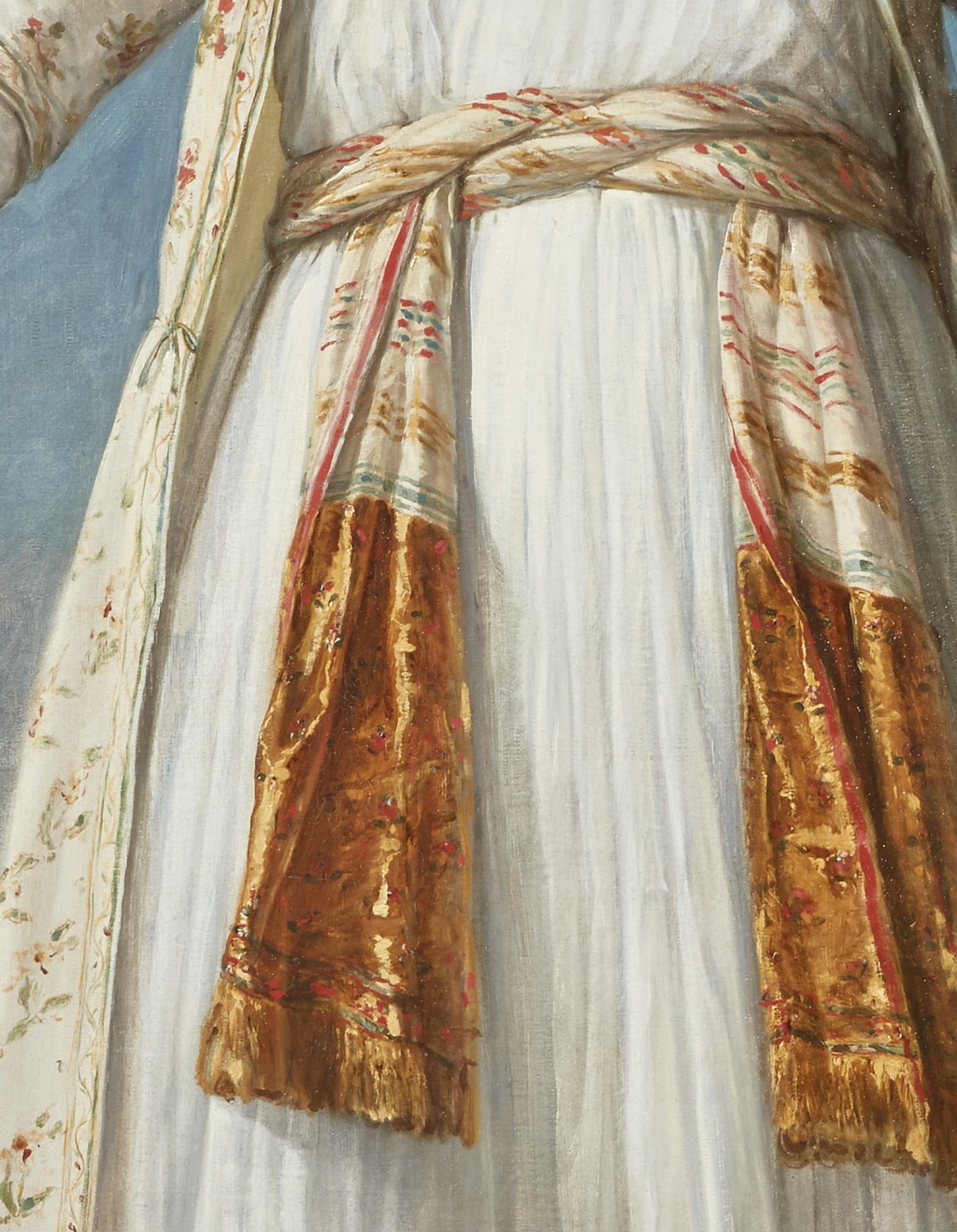
Photo : Sotheby's
The painting, along with that of Dervish Khan’s fellow ambassador Osman Khan, was exhibited at the Salon of 1789, which opened in August despite the disquieting political climate. Both pictures were displayed prominently, as shown in a drawing of the exhibition by Charles de Wailly.

Projet rétrospectif pour la présentation des ouvrages de l'Académie au Salon carré du Louvre en 1789.
Charles de Wailly, 1789
Photo : Musée Carnavalet, Histoire de Paris
They were received by the public with immense curiosity and critical acclaim. By October, however, Vigée had fled Paris in fear of her life after mobs had invaded Versailles.
Given that the painting next appears in the estate sale of her husband, Jean-Baptiste Pierre Le Brun, it can be surmised that she kept the work in her personal collection but left it at home in France when she went to Italy. Vigée’s portrait of Osman Khan is also included in Le Brun’s auction, though it has since been lost.
* Source et infos complémentaires : Sotheby's - Master Paintings Evening Sale
Le portrait de Muhammad Dervish Khan, par Elisabeth Vigée Le Brun, s'est envolé ce 30 janvier pour 7,2 millions de dollars.
Record mondial pour l'artiste, et record mondial pour une oeuvre peinte par une femme (période pré-moderne).

Elisabeth-Louise Vigée Le Brun
PORTRAIT OF MUHAMMAD DERVISH KHAN, FULL-LENGTH, HOLDING HIS SWORD IN A LANDSCAPE
Signed and dated lower right: L. Vigée Le Brun / 1788
oil on canvas / 88 3/4 by 55 1/2 in.; 225.5 by 136 cm.

Photo : Sotheby's
Si le sujet vous intéresse, je vous recommande la lecture de la note au catalogue publiée par Sotheby's (en anglais).
Vous y retrouverez raconté l'histoire de cette ambassade et celle de ce tableau.
Extraits de la note au catalogue :
This imposing and potent portrait by Elisabeth-Louise Vigée Le Brun depicts Muhammad Dervish Khan, the Indian ambassador sent to France by the powerful Mysore ruler Tipu Sultan.
Painted in the summer of 1788 and exhibited at the Salon of 1789, when political unrest had begun to boil in France, the work is an evocative account of France’s fascination with the East as well as Vigée’s resourcefulness in acquiring this unique commission.
It is obvious that both Dervish Khan and Vigée would have found each other equally exotic and endlessly fascinating: one, a powerful Indian man parading around Paris in elegant muslin and gold-embroidered costumes, the other a woman artist who held such sway that she could get the King of France to request the sitting.
(...)
As Muslim men, the idea of having themselves represented pictorially, let alone by a female artist, was unheard of.
Vigée tenacity and resourcefulness in achieving the sitting was a remarkable feat. After the request came from the King, they agreed to sit for her at their hôtel in Paris.
Her detailed description of the encounter in her memoirs provides a fascinating look into this awkward clash of cultures. She is thrown by their sprinkling of rosewater on her hands upon her entering, and later at dinner is shocked when she finds the dining room set for them to sit down on the floor.
She painted Dervish Khan first, “standing, with his hand on his dagger. He threw himself into such an easy, natural position of his own accord that I did not make him change it.”

Photo : Sotheby's
When the paintings had finished drying, Vigée sent for the works but was refused; Dervish Khan had hidden his portrait behind the bed.

As Vigée enthusiastically recalls, she strategically convinced his servant to steal it back for her, only to later hear that Dervish Khan had then planned to murder the servant for this transgression.
Luckily, an interpreter convinced the ambassador that murdering your valet was not acceptable practice in France, and he falsely claimed that it was the King who wanted the portrait.

(...)

Photo : Sotheby's
The painting, along with that of Dervish Khan’s fellow ambassador Osman Khan, was exhibited at the Salon of 1789, which opened in August despite the disquieting political climate. Both pictures were displayed prominently, as shown in a drawing of the exhibition by Charles de Wailly.

Projet rétrospectif pour la présentation des ouvrages de l'Académie au Salon carré du Louvre en 1789.
Charles de Wailly, 1789
Photo : Musée Carnavalet, Histoire de Paris
They were received by the public with immense curiosity and critical acclaim. By October, however, Vigée had fled Paris in fear of her life after mobs had invaded Versailles.
Given that the painting next appears in the estate sale of her husband, Jean-Baptiste Pierre Le Brun, it can be surmised that she kept the work in her personal collection but left it at home in France when she went to Italy. Vigée’s portrait of Osman Khan is also included in Le Brun’s auction, though it has since been lost.
* Source et infos complémentaires : Sotheby's - Master Paintings Evening Sale
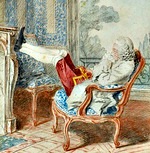
La nuit, la neige- Messages : 18132
Date d'inscription : 21/12/2013
 Re: Galerie virtuelle des oeuvres de Mme Vigée Le Brun
Re: Galerie virtuelle des oeuvres de Mme Vigée Le Brun
7,2 millions... c'est énorme pour Mme Vigée-Lebrun ! 
Le portrait de la princesse de Lamballe avait atteint 130 000 euros il y a quelques années (avant l'exposition).
Donc c'est vraiment extraordinaire. De mémoire, je crois qu'il était présenté à l'exposition les "Visiteurs de Versailles" ...
Le portrait de la princesse de Lamballe avait atteint 130 000 euros il y a quelques années (avant l'exposition).
Donc c'est vraiment extraordinaire. De mémoire, je crois qu'il était présenté à l'exposition les "Visiteurs de Versailles" ...

Duc d'Ostrogothie- Messages : 3227
Date d'inscription : 04/11/2017

Gouverneur Morris- Messages : 11795
Date d'inscription : 21/12/2013
 Voile Rouge
Voile Rouge
Bonjour, je viens de parcourir votre forum avec grand enthousiasme.
J'ai néanmoins une question. J'ai pu remarquer que les jeunes femmes étaient représentées en robe blanche ce qui me fait penser à la pureté de la jeunesse, mais elles ont très souvent également un châle rouge. Pensez vous que cela représente un passage à l'age adulte avec la couleur de la passion ?
Merci pour vos partages de tableaux magnifiques.
Peschila- Messages : 3
Date d'inscription : 25/02/2019
 Re: Galerie virtuelle des oeuvres de Mme Vigée Le Brun
Re: Galerie virtuelle des oeuvres de Mme Vigée Le Brun
Bonsoir, Peschila.
Soyez la très bienvenue dans le Forum de Marie-Antoinette !

_________________
... demain est un autre jour .

Mme de Sabran- Messages : 55497
Date d'inscription : 21/12/2013
Localisation : l'Ouest sauvage
 Re: Galerie virtuelle des oeuvres de Mme Vigée Le Brun
Re: Galerie virtuelle des oeuvres de Mme Vigée Le Brun
Est-ce spécialement dans ce sujet que vous avez remarqué ces robes blanches accompagnées d'un voile rouge ?
Je vais le survoler en diagonale pour constater ... et je reviens vers vous.
Je vais le survoler en diagonale pour constater ... et je reviens vers vous.
_________________
... demain est un autre jour .

Mme de Sabran- Messages : 55497
Date d'inscription : 21/12/2013
Localisation : l'Ouest sauvage
 Re: Galerie virtuelle des oeuvres de Mme Vigée Le Brun
Re: Galerie virtuelle des oeuvres de Mme Vigée Le Brun
Bonsoir Peschila, soyez la bienvenue parmi nous... 
Vous posez là une question intéressante, à laquelle je ne suis pas capable de vous répondre. Je ne suis pas très doué en symbolique des couleurs picturales.
Peut-être que l'un de nos membres mieux informé pourra le faire ?
 Sur ce magnifique portrait, la princesse Golitsyna est peinte avec un châle rouge.
Sur ce magnifique portrait, la princesse Golitsyna est peinte avec un châle rouge.
Mais ce n'est plus une jeune fille, et son passage à l'âge adulte n'est pas envisageable. Née en en 1772, elle a vingt-six ans lorsque Madame Le Brun la peint.

Maria Grigorievna Viazemskaïa, Princess Golitsyna (1772-1865), seated three-quarter-length
By Elisabeth-Louise Vigée Le Brun
Oil on canvas,1798
signed, dated, and inscribed ‘L.E. Vigée / Le Brun / a petersbourg / 1798’ (lower right)
Photo : Christie's
Mais, certes, elle ne porte pas une robe blanche.
Le portrait de Juliane Henriette Ulrike de Saxe-Cobourg-Saalfeld, future Grande duchesse Anna Feodorovna, nous montre une toute jeune.
Née en 1781, elle serait peinte vers 1795-96, et peu après son mariage nous dit Wikipedia.
Pas de robe blanche non plus.
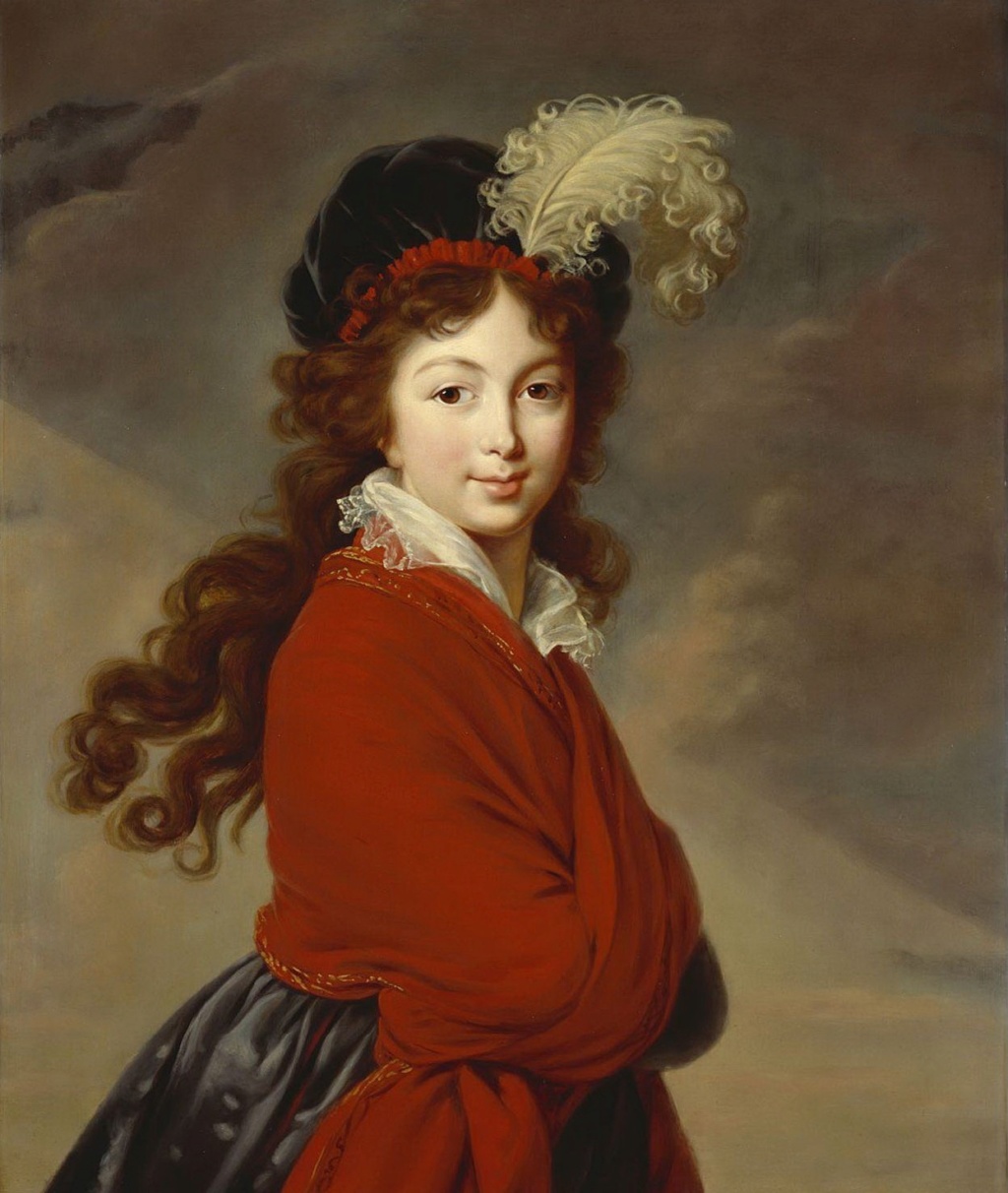
La Grande Duchesse Anna Feodorovna (1795-1796), born Princess Juliane von Saxe-Coburg-Saalfeld
Portrait by Élisabeth-Louise Vigée-Le Brun
Source : Wikipedia
Peschila a écrit:
J'ai néanmoins une question. J'ai pu remarquer que les jeunes femmes étaient représentées en robe blanche ce qui me fait penser à la pureté de la jeunesse, mais elles ont très souvent également un châle rouge. Pensez vous que cela représente un passage à l'age adulte avec la couleur de la passion ?
Vous posez là une question intéressante, à laquelle je ne suis pas capable de vous répondre. Je ne suis pas très doué en symbolique des couleurs picturales.
Peut-être que l'un de nos membres mieux informé pourra le faire ?
Mais ce n'est plus une jeune fille, et son passage à l'âge adulte n'est pas envisageable. Née en en 1772, elle a vingt-six ans lorsque Madame Le Brun la peint.

Maria Grigorievna Viazemskaïa, Princess Golitsyna (1772-1865), seated three-quarter-length
By Elisabeth-Louise Vigée Le Brun
Oil on canvas,1798
signed, dated, and inscribed ‘L.E. Vigée / Le Brun / a petersbourg / 1798’ (lower right)
Photo : Christie's
Mais, certes, elle ne porte pas une robe blanche.
Le portrait de Juliane Henriette Ulrike de Saxe-Cobourg-Saalfeld, future Grande duchesse Anna Feodorovna, nous montre une toute jeune.
Née en 1781, elle serait peinte vers 1795-96, et peu après son mariage nous dit Wikipedia.
Pas de robe blanche non plus.

La Grande Duchesse Anna Feodorovna (1795-1796), born Princess Juliane von Saxe-Coburg-Saalfeld
Portrait by Élisabeth-Louise Vigée-Le Brun
Source : Wikipedia

La nuit, la neige- Messages : 18132
Date d'inscription : 21/12/2013
 Re: Galerie virtuelle des oeuvres de Mme Vigée Le Brun
Re: Galerie virtuelle des oeuvres de Mme Vigée Le Brun
Il est vrai que Flore, Mme de Staël ou la princesse Youssoupov illustrent tout à fait votre propos. 
Quant à la représentation symbolique du blanc = la pureté, et du rouge = la passion, j'en suis d'accord .
Mais ce peut être aussi, plus simplement, un choix de couleurs seyantes, flatteuses, très heureusement contrastées afin de frapper le regard, le blanc devient lumière et le rouge chaleur ?
J'espère que nos amis spécialistes de Mme Le Brun ou de la mode vestimentaire sauront vous en dire plus ...
Quant à la représentation symbolique du blanc = la pureté, et du rouge = la passion, j'en suis d'accord .
Mais ce peut être aussi, plus simplement, un choix de couleurs seyantes, flatteuses, très heureusement contrastées afin de frapper le regard, le blanc devient lumière et le rouge chaleur ?
J'espère que nos amis spécialistes de Mme Le Brun ou de la mode vestimentaire sauront vous en dire plus ...

_________________
... demain est un autre jour .

Mme de Sabran- Messages : 55497
Date d'inscription : 21/12/2013
Localisation : l'Ouest sauvage
 Re: Galerie virtuelle des oeuvres de Mme Vigée Le Brun
Re: Galerie virtuelle des oeuvres de Mme Vigée Le Brun
Bonjour, merci pour vos réponses rapides. 
Peut être était-ce finalement la mode de l'époque que de porter un châle rouge.
Il me semble que c'était aussi le cas au début du 19eme siècle avec l’impératrice Joséphine qui lança la mode avec les tissus remmenés des voyages.
Je me posais la question après avoir remarqué plusieurs fois cet accoutrement durant ce topic mais cela n'a pas grande importance.
Peut être était-ce finalement la mode de l'époque que de porter un châle rouge.
Il me semble que c'était aussi le cas au début du 19eme siècle avec l’impératrice Joséphine qui lança la mode avec les tissus remmenés des voyages.
Je me posais la question après avoir remarqué plusieurs fois cet accoutrement durant ce topic mais cela n'a pas grande importance.
Peschila- Messages : 3
Date d'inscription : 25/02/2019
 Re: Galerie virtuelle des oeuvres de Mme Vigée Le Brun
Re: Galerie virtuelle des oeuvres de Mme Vigée Le Brun
Ce n'est pas une œuvre de Mme Vigée Le Brun mais je vous partage ce tableau en rapport avec ma question que je trouve saisissant, notamment au niveau du détails dans les habits.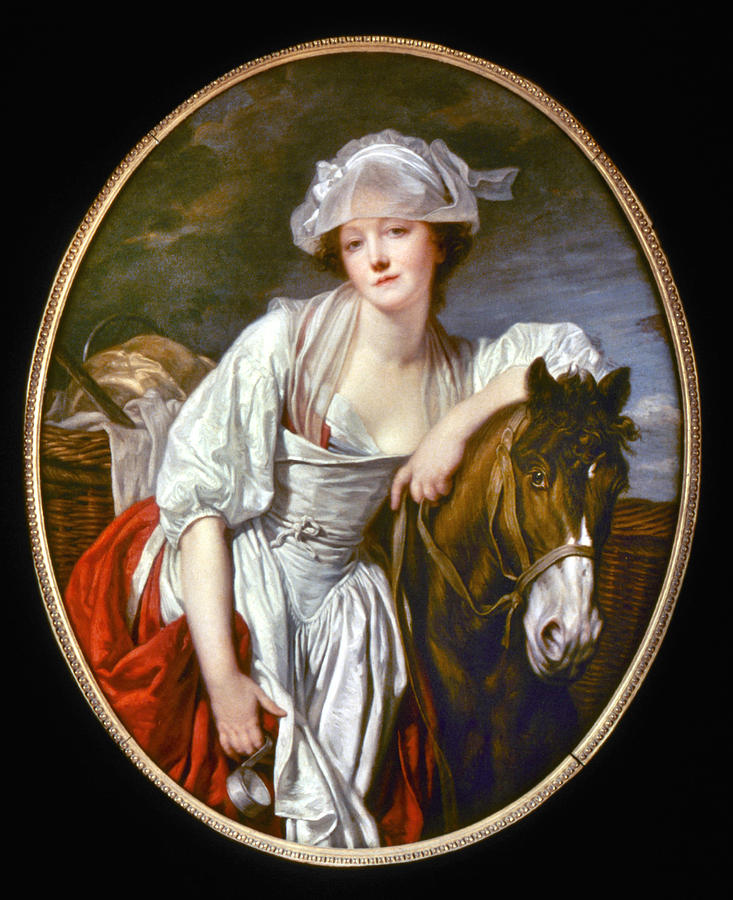
C'est un tableau de Jean-Baptiste Greuze peint en 1765.

C'est un tableau de Jean-Baptiste Greuze peint en 1765.
Peschila- Messages : 3
Date d'inscription : 25/02/2019
 Re: Galerie virtuelle des oeuvres de Mme Vigée Le Brun
Re: Galerie virtuelle des oeuvres de Mme Vigée Le Brun
Peschila a écrit: ce tableau en rapport avec ma question que je trouve saisissant.
... parce que cette femme porte du rouge et du blanc ? ... sinon je ne vois pas bien le rapport .

Elle ne rappelle pas beaucoup les aristocratiques modèles de Mme Le Brun . C'est une paysanne au visage grave, au regard fatigué. Son attitude aussi exprime la lassitude, enfin me semble-t-il .
_________________
... demain est un autre jour .

Mme de Sabran- Messages : 55497
Date d'inscription : 21/12/2013
Localisation : l'Ouest sauvage
 Re: Galerie virtuelle des oeuvres de Mme Vigée Le Brun
Re: Galerie virtuelle des oeuvres de Mme Vigée Le Brun
Le rouge est omniprésent dans l'œuvre de Madame Vigée-Le Brun, parfois en petite touche et souvent sous forme de ce châle que l'on retrouve dans énormément de ses toiles.
Je n'y vois pas une signification symbolique mais plutôt un choix pictural en lien avec le stylisme des tenues de ses modèles auquel elle attachait beaucoup d'importance de même qu'aux coiffures.
La paysanne de Greuze est étonnante dans cet attitude en effet un peu lasse mais en même temps presque moderne qui pourrait être celle d'une jeune femme dans un magazine d'aujourd'hui. Personnellement j'aime beaucoup.

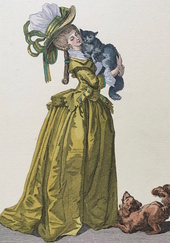
Marie-Jeanne- Messages : 1497
Date d'inscription : 16/09/2018
 Re: Galerie virtuelle des oeuvres de Mme Vigée Le Brun
Re: Galerie virtuelle des oeuvres de Mme Vigée Le Brun
Les notes de présentation de la maison de vente, que je cite en extraits, sont intéressantes...
- Élisabeth-Louise Vigée Le Brun (Paris 1755-1842)
A young woman, bust-length, in a white blouse
oil on canvas, oval
16 1/8 x 12 ¾ in. (41 x 32.4 cm.)
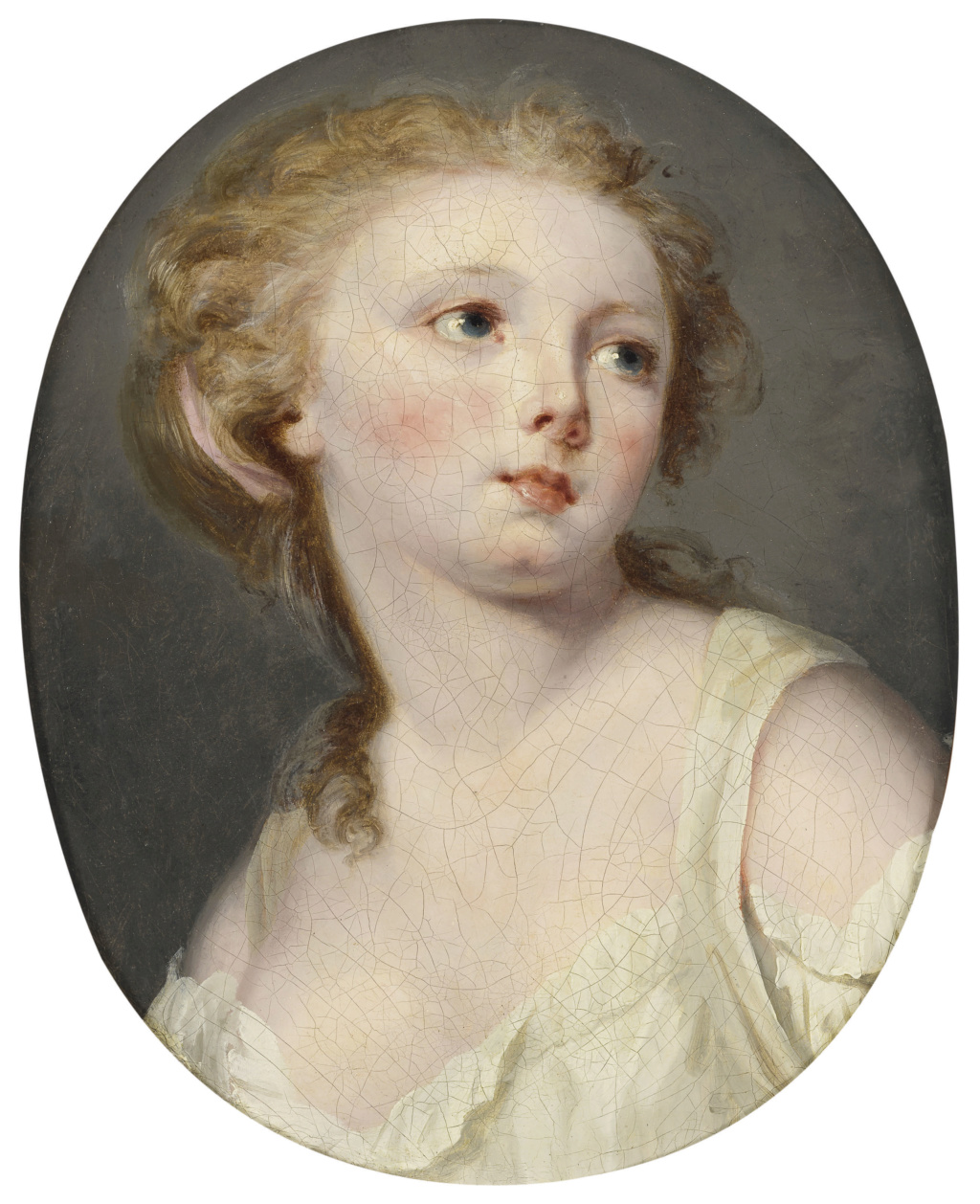
Photo : Christie's
Lot Essay :
This small bust-length depiction of a blue-eyed, young girl, with her head lifted and turned to her left, might properly qualify as a figure d’expression, a genre that had been popularized in the 1760s by Jean Baptiste Greuze and was later much imitated by his contemporaries and followers.
Among them was the young Élisabeth Louise Vigée, who as a very young girl, in order to improve her skills, had copied “heads” by Greuze.
After her father’s death in 1767, she was accompanied by her mother on visits to the most important art collections of the time, such as those of the Duc d’Orléans, the Duc de Choiseul Praslin, the tax collector Pierre Louis Paul Randon de Boisset and the banker François Michel Harenc de Presle:
“As soon as I entered into one of these splendid galleries, I could have been perfectly compared to a bee because I was storing in my mind knowledge and memories useful to my art as I became inebriated with the enjoyment of contemplating the Old Masters. Moreover, to fortify myself I would copy a numbers of paintings by Rubens, Rembrandt, Van Dyck, and several head of young girls by Greuze because these taught me so much about half-tones that are found in delicate complexions.”
(É.L. Vigée Le Brun, Souvenirs, Paris, 1835, I, p. 19 [translated by the author].)
(...)
This painting will be included in the catalogue raisonné of the works of Élisabeth-Louise Vigée Le Brun by Joseph Baillio.
* Source et infos complémentaires : Christie's NY - Vente Old Masters (1er mai 2019)
______________________
- Élisabeth-Louise Vigée Le Brun (Paris 1755-1842)
Portrait of a young girl, half-length
oil on canvas, circular
22¼ in. (56.5 cm.) diameter

Photo : Christie's
Lot Essay :
This charming portrait of a child is one of the earliest oil paintings that the artist executed, soon after she lost her father, the pastellist Louis Vigée, in May of 1767, when she was barely twelve years old.
“I was so prostrate with grief that I waited a great length of time before picking up my chalks again. Doyen [the history painter Gabriel François Doyen] came to see us from time to time, and as he had been my father’s best friend, his visits were greatly consoling for us. It was he who convinced me to take up once again my beloved occupation in which, as a matter of fact, I found the only distraction that could soothe my sorrows and take me away from my sad refections.
It was at this point that I began to paint from nature. I made in succession a number of portraits in pastel and in oils.”
(Élisabeth Louise Vigée Le Brun, Souvenirs, Paris, Librairie Hippolyte Fournier, vol. I, p. 14.)
The painting represents a blue-eyed girl barely out of babyhood seated on a chair upholstered in bluish-green velvet. The child is ftted out like a diminutive adult woman in a pink frock with a low décolletage trimmed with ribbons of the same color. Covering her hair is a bonnet known as a baigneuse (or a dormouse) adorned with pink ribbons, which in turn is covered with a transparent veil tied in a bow at the neck with white strips of satin or silk.
Beside her is a small table bearing a glass or crystal vase of fowers, at the base of which is a white blossom on which a butterfy has alighted. The brushwork is uninhibited and rather rudimentary. The neutral background is painted with a frottis or scumble of gray paint over a very light-colored ground, a technique used by the artist from the outstet of the sitter's career.
This immature technique marks one of the first of the young artist’s oil paintings and her name may be featured on the “Liste des tableaux et des portraits que j’ai fait avant de quitter la France en 1789” under the early years : “De 1768 à 1772”.
A few years later Vigée Le Brun painted two other charming likenesses of children.
One of these is the double-portrait of two children building a House of Cards (the so-called Children of the Baronne d’Esthal, an identity taken from the artist’s frst list of her sitters where the Alsatian name ‘Eichthall’ is misspelled, which was last recorded in the collection of an heir of the Parisian art dealer Paul Cailleux, called ‘Cayeux de Senarpont (1884-1964),’ and his widow, née Judith-Marguerite Serf (1882-1973).
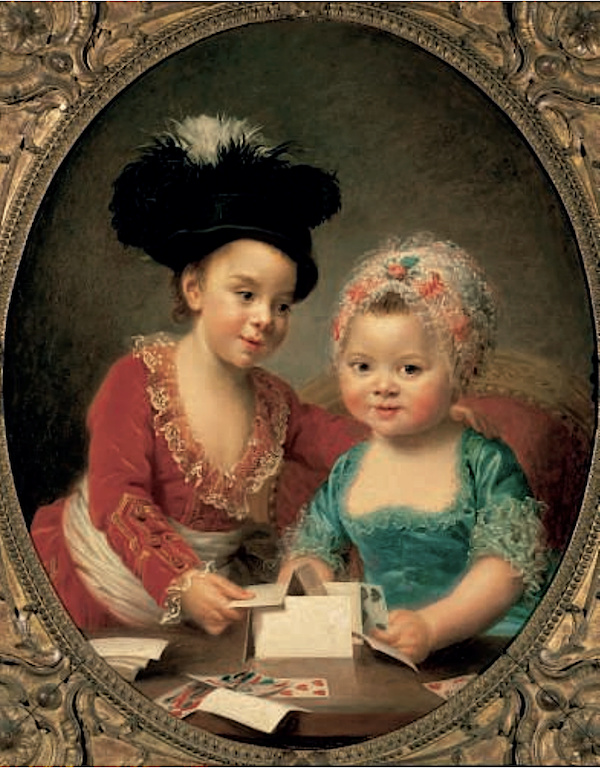
The Children of the Baronne d’Esthal
Oil on canvas, private collection.
Photo : Christie's
A second, the little daughter of the younger of the two brothers of Louis XVI, Charles Philippe de Bourbon, Comte d’Artois, and his Sardinian wife, née Maria Teresa di Savoia, the brown-eyed infant “Mademoiselle” Sophie d’Artois, a signed and dated oval canvas formerly in the Irma N. Straus collection and with the Galerie Maurice Segoura.
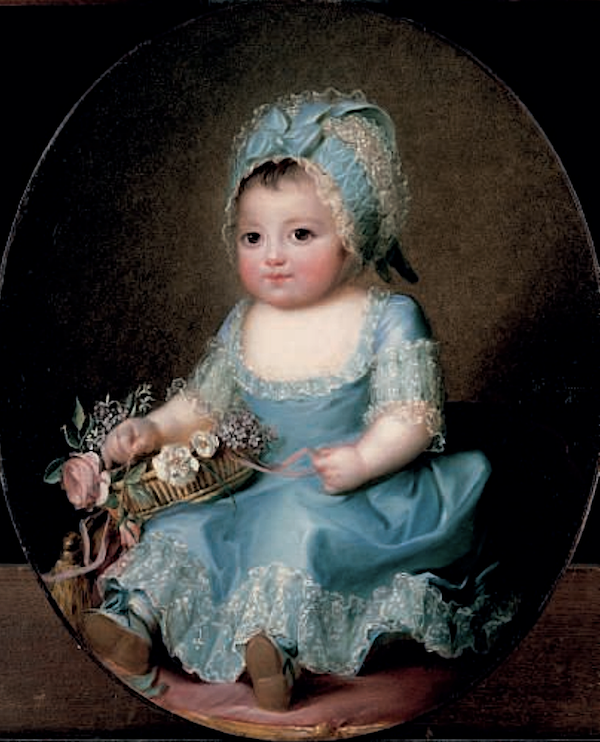
Mademoiselle Sophie d’Artois
Oil on canvas, private collection.
Photo : Christie's
This work will be included in the catalogue raisonné of the works of Vigée Le Brun being prepared by Joseph Baillio.
Joseph Baillio
* Source et infos complémentaires : Christie's N.Y - Vente du 30 avril 2019

La nuit, la neige- Messages : 18132
Date d'inscription : 21/12/2013
 Re: Galerie virtuelle des oeuvres de Mme Vigée Le Brun
Re: Galerie virtuelle des oeuvres de Mme Vigée Le Brun
Présenté le 4 juillet 2019, par Christie's Londres :
- Elisabeth-Louise Vigée Le Brun (Paris 1755-1842)
Portrait of Emma Hart, later Lady Hamilton (1765-1815), as the Cumaen Sibyl
Oil on canvas
54 ½ x 39 in. (138.4 x 99 cm.)
Provenance : (Probably) Timoléon de Cossé-Brissac, duc de Brissac (1775-1848), and by descent in the family until 1919 (...)

Photo : Christie's
Note au catalogue (extraits)
This celebrated portrait of the famed beauty Emma Hart, later Lady Hamilton, stands as a testament to the abilities of one of the most talented female artists in the canon.
Known in two versions, the portrait achieved almost immediate renown and remained, for the rest of her life, Vigée Le Brun’s greatest achievement.
She herself felt that the portrait represented the pinnacle of her career, as it, of all her works, most successfully transcended portraiture, entering into the academically hallowed field of history painting. It also remained one of her favourite works.
In her Souvenirs of 1835, Vigée Le Brun recounted the effect the work had on a group of young artists in Parma:
‘Having spoken of their desire to meet me, they continued by saying that they would very much like to see one of my paintings. Here is one I have recently completed, I replied, pointing to the Sibyl. At first their surprise held them silent; I consider this far more flattering than the most fulsome praise; several then said that they had thought the painting the work of one of the masters of their school; one actually threw himself at my feet, his eyes full of tears.
I was even more moved, more delighted with their admiration since the Sibyl had always been one of my favourite works. If any among my readers would accuse me of vanity, I beg them to reflect that an artist works all his life to experience two or three moments such as the one I have just described.’
Earlier depictions of Emma painted by George Romney, such as Emma Hart as Circe (Rothschild Collection, Waddesdon Manor), a sketch for which is at Tate Britain, and Emma Hart as Ariadne (London, National Maritime Museum), though they may have pertained to depict her in classical guise, remained rooted in the British portraiture tradition.
However, Le Brun’s more mature work can only be correctly understood in respect to the Italian trajectory that led her to artists such as Annibale Carracci, and from him to Domenichino, whose own Cumaean Sybil (Rome, Galleria Borghese) has rightly been identified as one of the direct influences on the present composition.

The Sibilla Cumana (Cumaean Sibyl)
Domenicho Zampieri (Domenichino)
17th Century
Galleria Borghese
Photo : Wikipedia
As evidenced by the present portrait, Le Brun’s wonderfully rich and controlled brushwork lends itself perfectly to the earlier master’s style, which aimed to surpass the imperfections of nature, developing a superior idea del bello (idea of beauty). Indeed, her composition can be said to have bettered even Emma’s legendary beauty, as the artist herself recounted:
‘I went [to the Hamilton residence] everyday, desiring to progress quickly with the picture.
The duchesse de Fleury and the Princess Joseph de Monaco were present at the third sitting, which was the last. I had wound a scarf round her head in the shape of a turban, one end hanging down in graceful folds. This headdress so beautified her that the ladies declared she looked ravishing ... She went to her apartment to change [for dinner], and when she came back … her new costume, which was a very ordinary one … had so altered her to her disadvantage that the two ladies had all the difficulty in the world in recognising her’.
As the French Revolution erupted violently in July 1789, Vigée Le Brun fell into a depression and, realising that her close association with Queen Marie-Antoinette placed her in danger, sought refuge in the homes of relatives.
On 6 October, as the mobs were invading Versailles to take the royal family back to Paris, she fled France in one of the first waves of emigration, departing for Rome with her daughter and her governess, in what would be the start of a twelve-year exile. Although personally unsettling, her years in exile were professionally successful and highly productive as she travelled through Italy, Austria, Russia, Germany, England and Switzerland, welcomed into each European court as a revered survivor of the final days of the Ancien Régime and showered with commissions from foreign aristocrats and fellow refugees alike.
Vigée Le Brun arrived in Naples in April 1790, having received a number of important commissions there arranged through the intervention of Queen Maria Carolina, a sister of Marie-Antoinette.
Over the next two years, the artist shuttled back and forth between Naples and Rome, necessitated by her relentless schedule of portrait commissions.
It was on her third extended stay in Naples, in the spring of 1791, that she began work on the portrait of Emma Hamilton as the Cumaean Sibyl, the work that the artist herself would come to regard as her personal favourite.
It is the last of three portraits that Vigée Le Brun made of the celebrated beauty who, just a few months later, would become the wife of Sir William Hamilton (1730-1803), English Minister to Naples and a renowned archeologist, vulcanologist, and connoisseur of ancient art, whose collection of antiquities, vases and carved gems would eventually form the nucleus of the British Museum.
Vigée Le Brun writes in her Souvenirs (1835) that she met her glamorous sitter only days after she arrived in Naples in the spring of 1790, when Sir William Hamilton appeared at her studio and introduced them:
‘…he requested that my first portrait in the town might be that of an exceptionally beautiful woman whom he introduced to me as Mme. Hart, his mistress; she later became Lady Hamilton, and her beauty brought her great fame.’
A legendary beauty, Emma Hart was, by the time of her first meeting with Vigée Le Brun, one of the most frequently painted models in Europe and famously the subject of dozens of portraits by George Romney, as well as by a host of other painters throughout the continent.
‘The life of Lady Hamilton reads like a romantic fiction,’ wrote Vigée Le Brun.
(...)
Vigée Le Brun painted three portraits of Emma Hart, works that are as much history paintings as likenesses of their famous sitter.
In the first, Emma is depicted as a Bacchante (or Ariadne) reclining in a grotto by the sea. That work, now in a private collection, was commissioned by Sir William Hamilton and begun shortly after their first meeting in the spring of 1790.

Lady hamilton as Bacchante (or Ariadne)
Oil on canvas, 1792
A faithful small copy by Henry Bone is in the Wallace Collection in London.
Image : Batguano.com
In the second portrait (Cheshire, Port Sunlight, Lady Lever Art Gallery), which the artist retained in her own collection until her death in 1842, Emma is shown at three-quarter-length dancing before Mount Vesuvius with a tambourine in her hand.

Lady Hamilton en Bacchante dansant devant le Vésuve
Oil on canvas, circa 1790
Image : National Museums Liverpool via Wikipedia
For the third and final portrait, which Vigée Le Brun considered one of her masterpieces, the sitter appears as the Cumaean Sibyl, writing a Greek text on a scroll.
In antiquity, the Sibyl of Cumae – named after the site of a town founded by the Greeks northwest of Naples on the coast of Campania – was a seer and oracle who uttered prophesy under the divine inspiration of Apollo.
The three sittings that Emma gave the artist took place in the summer of 1791 at the Hamilton villa at Caserta, 25 miles north of Naples.
Vigée Le Brun finished the portrait somewhat later, following her return to Rome, at which point she signed and dated it ‘1792’.
It appears to have been commissioned by the comtesse du Barry’s lover, the duc de Brissac, then the governor of Paris and head of Louis XVI’s palace guard.
The original painting is today in the Capricorn Foundation at Ramsbury Manor, Wiltshire.

Lady Hamilton as the Cumaean Sibyl
Oil on canvas, 1792
Pas mieux comme image, désolé ! Source : Batguano.com
The present painting is an exact, autograph replica of the prime version.


Photos : Christie's
Why Vigée Le Brun made two versions of the painting, of equally high quality and in quick succession, is unclear.
Joseph Baillio has speculated that the immediate acclaim with which the painting was received may have prompted the artist to keep it for herself, to accompany her from city to city in her exile as her artistic ‘calling card’.
If this theory is correct, the present replica would then have been made to fulfil the commission from Brissac and, indeed, the present canvas was in the Cossé-Brissac collection in Paris until 1919.
It may also have been the version sent to Paris from St. Petersburg to be exhibited in the Salon of 1798; a full-sized version was in the estate sale of the artist’s ex-husband, J.-B.-P. Le Brun, sold at auction on 16 May 1814, lot 80.
However, it is also possible that she kept the signed and dated picture for herself simply because, by the time it was completed and ready for delivery, the duc de Brissac was dead, having been slain in a revolutionary massacre on 9 September 1792.
In any event, Vigée Le Brun kept the prime version, which travelled with her to Austria, Russia, Germany and England, and was used to advertise and promote her unexcelled abilities as a portrait painter; it was only in 1819 that she was coerced into selling it to the duc de Berry.
A superb, bust-length version of the composition (today in a private collection) appears in the list of paintings from her hand that Vigée Le Brun included as an appendix to her memoirs; she presented it as a gift to Sir William Hamilton who, she notes acidly, ‘without hesitating, sold it.’
It appeared in Hamilton’s sale at Christie’s in 1801, lot 28, and was purchased there by Alleyne FitzHerbert, 1st Baron St Helens, who also owned Mme Le Brun’s original Self-Portrait of the Artist Wearing a Straw Hat (1782; Private collection).


Photos : les reporters du Forum de Marie-Antoinette.

Vigée Le Brun was certainly prompted to paint Emma Hart in historical guises in all three portraits of her by the sitter’s much-admired talent for ‘Attitudes’ and by Hamilton’s enthusiasm for them.
The present painting is virtually a tableau vivant laid down on canvas, with the sitter dressed in ‘Greek’ costume and a turban flatteringly framing her lovely face as she gazes heavenward for inspiration.
The picture’s great success was born of Vigée Le Brun’s ability to convey Emma’s beauty, sensuality and pure animal magnetism with such force while still maintaining a sense of dignity and decorum.
Soon after completing it, she took it with her on a journey to Vienna. Here, she explains :
’I immediately painted the portrait of the daughter of the Spanish Ambassador, mademoiselle de Kaguenek … as well as the Baron and Baroness de Strogonoff. My Sibyl, which people came in their droves to admire, played no small part in convincing people to ask me to paint them’.
If Vigée Le Brun’s later years were filled with more triumphs and continuing professional success, Emma Hart’s years were to be far fewer in number and marked by sorrows.
(...)
Note : We are grateful to Joseph Baillio for his assistance with this entry. He will be including the present lot in his forthcoming catalogue raisonné of the paintings of Vigée Le Brun.
Source : Christie's London - Old Masters Evening Sale, 4 July 2019

La nuit, la neige- Messages : 18132
Date d'inscription : 21/12/2013
 Re: Galerie virtuelle des oeuvres de Mme Vigée Le Brun
Re: Galerie virtuelle des oeuvres de Mme Vigée Le Brun
Ce portrait, prochainement présenté en vente aux enchères, présente quelques caractéristiques assez rares dans l'oeuvre de l'artiste. La peintre n'a que 17 ans lorsqu'elle réalise ce pastel. 
Je cite des extraits de l'intéressante note au catalogue :
Portrait d'Alexis-Féréol Perrin de Sanson (1733-1820)
Élisabeth Louise Vigée Le Brun (Paris 1755-1842 Paris)
signé et daté 'Melle Vigée/ 1772' (en bas à droite)
pastel sur papier
55.6 x 46.5 cm.

Présentation (extrait) :
Inédit, conservé dans la famille du modèle depuis sa réalisation en 1772, ce pastel de jeunesse d’Élisabeth Louise Vigée Lebrun réalisé alors qu’elle n’avait que 17 ans, apparaît aujourd’hui sur le marché de l’art pour la première fois. Peu de pastels de jeunesse de l'artiste sont connus, ce qui accentue la rareté du présent portrait d’homme en habit bleu.
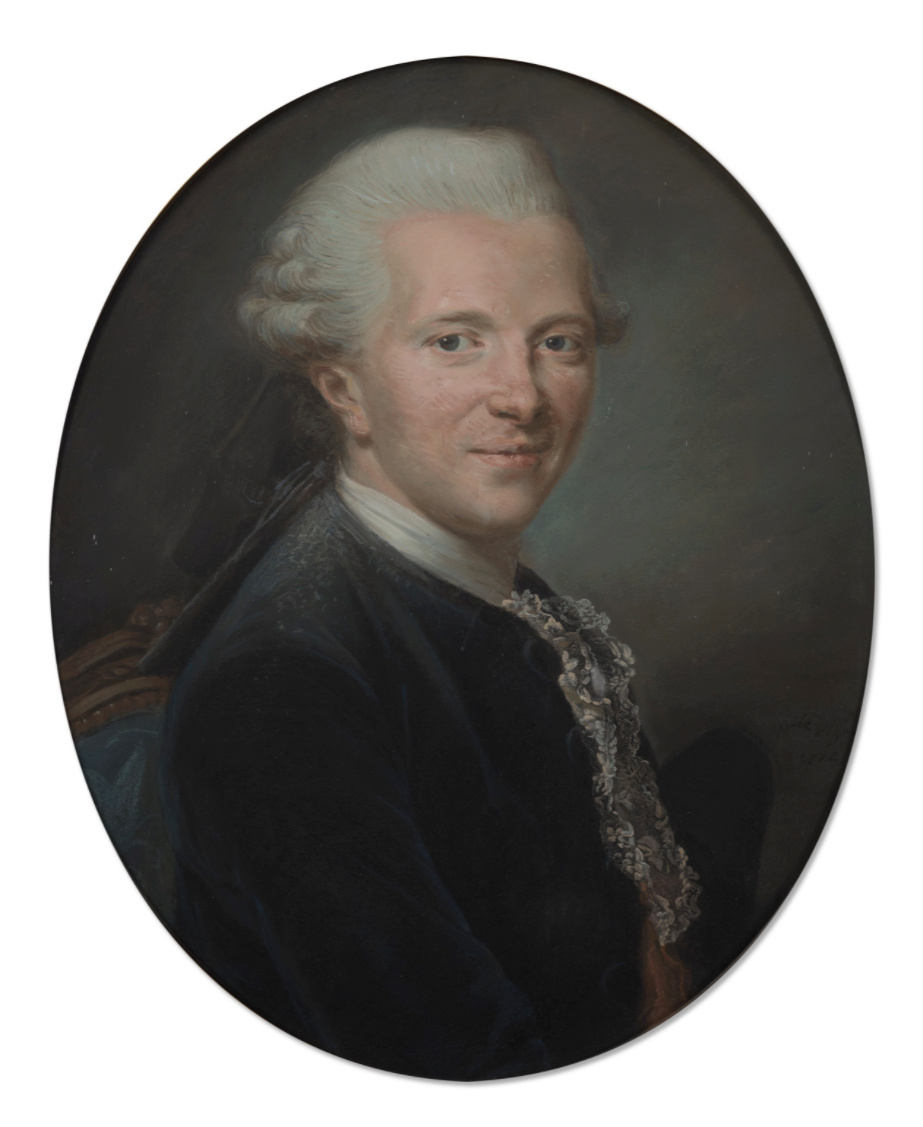
D’un talent précoce, Louise accède à l’atelier de son père pastelliste Louis Vigée (1715-1767) dès l’âge de onze et montre déjà de grandes aptitudes, avant d’intégrer une académie de dessin dirigée par Marie Rosalie Hallé, épouse du peintre Noël Hallé, puis prend conseil occasionnellement après de Gabriel-François Doyen et Joseph Vernet avant d’entrer à l’académie de Saint-Luc en 1774.
Dès le début de sa carrière, que Joseph Baillio considère pratiquement comme autodidacte, Louise Vigée tient une sorte de ‘ livre de raison ’ répertoriant les noms de ses modèles et dans lequel figure celui du présent modèle Alexis-Féréol Perrin de Sanson (1733-1842) (J. Baillio, Élisabeth-Louise Vigée Le Brun, cat. exp., Paris, Galeries nationales du Grand Palais, New York, The Metropolitan Museum of Art, Ottawa, Musée des Beaux-Arts du Canada, 2016, p. 15 ; et É.-L. Vigée Le Brun, op. cit., 1984).
Le modèle, Alexis-Féréol Perrin de Sanson (1733-1820), un avocat au parlement de Provence, contrôleur général alternatif du taillon en Provence est représenté en buste, souriant, à l’âge de trente-neuf ans, célibataire et sans descendance. Il était également bibliophile et sa collection fut dispersée en 1836 à Paris (M.A. Dumont et M.H. Lavigne, 'Documents nouveaux sur les Coypel et les Boullogne peintres et sur les Dumont sculpteurs 1712-1788', Nouvelles archives de l’art français. Recueil de documents inédits, Paris, 1887, p. 219 et 223).
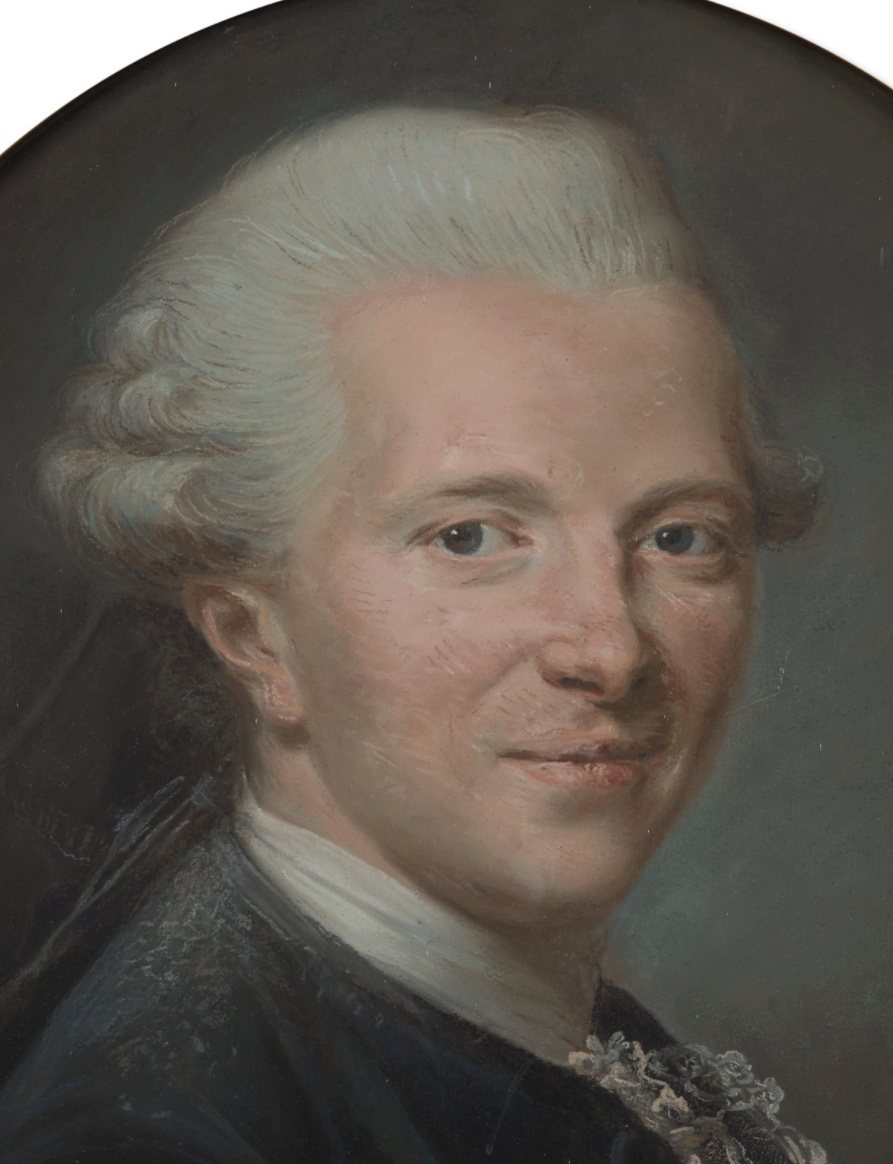
Les œuvres peintes et dessinées de mademoiselle Vigée pendant son adolescence sont souvent des portraits de son entourage à l’image de son frère peint en 1773, soit un an après le présent pastel (Saint Louis Art Museum, inv. 3 :1940 ; ibid., no. 19).
Si peu de pastels de jeunesse nous sont parvenus, les dessins à la pierre noire ou à la sanguine sont plus fréquents, réalisés sur le vif devant le modèle comme une première pensée : une Étude femme dite ‘Ma bonne’ conservée au musée Carnavalet à Paris (inv. D. 6447), une Jeune femme au voile ou encore une Jeune femme à la couronne de fleurs, toutes les deux au musée du Louvre (inv. 33 269 et RF 2783). La spontanéité du trait qui permet de capturer l’expression des visages se retrouvent très nettement dans le présent pastel, très esquissé et d’une grande fraîcheur.
Nous remercions Joseph Baillio et Neil Jeffares pour leur aide apportée à la rédaction de cette notice. Le pastel sera inclus par Joseph Baillio dans le catalogue raisonné de l'artiste en préparation.
* Source et infos complémentaires : Christie's Paris - Vente Women in Art (16 juin 2021)
 Si vous souhaitez découvrir quelques autres oeuvres de jeunesse de l'artiste, dont celui de son frère évoqué dans le descriptif, c'est ici
Si vous souhaitez découvrir quelques autres oeuvres de jeunesse de l'artiste, dont celui de son frère évoqué dans le descriptif, c'est ici  :
:
 Etienne Vigée, le frère d'Elisabeth Vigée Le Brun
Etienne Vigée, le frère d'Elisabeth Vigée Le Brun
Je cite des extraits de l'intéressante note au catalogue :
Portrait d'Alexis-Féréol Perrin de Sanson (1733-1820)
Élisabeth Louise Vigée Le Brun (Paris 1755-1842 Paris)
signé et daté 'Melle Vigée/ 1772' (en bas à droite)
pastel sur papier
55.6 x 46.5 cm.

Présentation (extrait) :
Inédit, conservé dans la famille du modèle depuis sa réalisation en 1772, ce pastel de jeunesse d’Élisabeth Louise Vigée Lebrun réalisé alors qu’elle n’avait que 17 ans, apparaît aujourd’hui sur le marché de l’art pour la première fois. Peu de pastels de jeunesse de l'artiste sont connus, ce qui accentue la rareté du présent portrait d’homme en habit bleu.

D’un talent précoce, Louise accède à l’atelier de son père pastelliste Louis Vigée (1715-1767) dès l’âge de onze et montre déjà de grandes aptitudes, avant d’intégrer une académie de dessin dirigée par Marie Rosalie Hallé, épouse du peintre Noël Hallé, puis prend conseil occasionnellement après de Gabriel-François Doyen et Joseph Vernet avant d’entrer à l’académie de Saint-Luc en 1774.
Dès le début de sa carrière, que Joseph Baillio considère pratiquement comme autodidacte, Louise Vigée tient une sorte de ‘ livre de raison ’ répertoriant les noms de ses modèles et dans lequel figure celui du présent modèle Alexis-Féréol Perrin de Sanson (1733-1842) (J. Baillio, Élisabeth-Louise Vigée Le Brun, cat. exp., Paris, Galeries nationales du Grand Palais, New York, The Metropolitan Museum of Art, Ottawa, Musée des Beaux-Arts du Canada, 2016, p. 15 ; et É.-L. Vigée Le Brun, op. cit., 1984).
Le modèle, Alexis-Féréol Perrin de Sanson (1733-1820), un avocat au parlement de Provence, contrôleur général alternatif du taillon en Provence est représenté en buste, souriant, à l’âge de trente-neuf ans, célibataire et sans descendance. Il était également bibliophile et sa collection fut dispersée en 1836 à Paris (M.A. Dumont et M.H. Lavigne, 'Documents nouveaux sur les Coypel et les Boullogne peintres et sur les Dumont sculpteurs 1712-1788', Nouvelles archives de l’art français. Recueil de documents inédits, Paris, 1887, p. 219 et 223).

Les œuvres peintes et dessinées de mademoiselle Vigée pendant son adolescence sont souvent des portraits de son entourage à l’image de son frère peint en 1773, soit un an après le présent pastel (Saint Louis Art Museum, inv. 3 :1940 ; ibid., no. 19).
Si peu de pastels de jeunesse nous sont parvenus, les dessins à la pierre noire ou à la sanguine sont plus fréquents, réalisés sur le vif devant le modèle comme une première pensée : une Étude femme dite ‘Ma bonne’ conservée au musée Carnavalet à Paris (inv. D. 6447), une Jeune femme au voile ou encore une Jeune femme à la couronne de fleurs, toutes les deux au musée du Louvre (inv. 33 269 et RF 2783). La spontanéité du trait qui permet de capturer l’expression des visages se retrouvent très nettement dans le présent pastel, très esquissé et d’une grande fraîcheur.
Nous remercions Joseph Baillio et Neil Jeffares pour leur aide apportée à la rédaction de cette notice. Le pastel sera inclus par Joseph Baillio dans le catalogue raisonné de l'artiste en préparation.
* Source et infos complémentaires : Christie's Paris - Vente Women in Art (16 juin 2021)
___________________________

La nuit, la neige- Messages : 18132
Date d'inscription : 21/12/2013
 Re: Galerie virtuelle des oeuvres de Mme Vigée Le Brun
Re: Galerie virtuelle des oeuvres de Mme Vigée Le Brun
La nuit, la neige a écrit:Le pastel sera inclus par Joseph Baillio dans le catalogue raisonné de l'artiste en préparation.
C'est la mention attendue dès lors qu'une Maison propose en vente publique un tableau de Madame Vigée Le Brun!
Et cela fait au moins 40 ans que nous attendons... Monsieur Baillio promettant cette somme au moins depuis l'époque de la première exposition consacrée à l'artiste, au Kimbell Art Museum de Fort Worth en 1982...
Sans aucun doute, ce travail fera date et sera - au sens propre - l'œuvre d'une vie!

En attendant, très intéressante découverte que ce pastel! Je me souviens de ceux exposés au Grand Palais en 2015-2016, une des belles séries de cette exposition mémorable, presque une surprise tant Vigée Le Brun - contrairement à Labille-Guiard - est peu identifiée à cette technique...

_________________
" Ai-je vu dans sa société quelque chose qui ne fût pas marqué au coin de la grâce, de la bonté et du goût? "
(Prince de Ligne, au sujet de "la charmante reine")
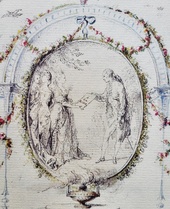
Bonnefoy du Plan- Messages : 390
Date d'inscription : 06/08/2018
Localisation : Le Maine
 Re: Galerie virtuelle des oeuvres de Mme Vigée Le Brun
Re: Galerie virtuelle des oeuvres de Mme Vigée Le Brun
Cette histoire de châle rouge dont nous parlions plus haut m'a intrigué et j'ai trouvé quelque chose qui pourrait (peut-être !) fournir un début d'explication...
J'ai découvert qu'à la fin du XVIIIème siècle et au XIXème, le jaune devient la couleur distinctive des prostituées. Et qu'au fil du temps, ces dernières se voient plus ou moins contraintes d'arborer un accessoire de cette couleur. Ainsi, en 1775, l'avocat Sabatier précise qu'à la foire de Beaucaire, les officiers municipaux ordonnent aux filles publiques de porter à leur coiffure une rosette de ruban jaune afin de les distinguer. Au siècle suivant, dans la peinture, c'est le châle jaune qui devient ce symbole et pour longtemps : en 1913, le peintre hollandais Kees Van Dongen fait scandale en représentant une femme nue, en l'occurence son épouse. Parce qu'elle est nue ? Non, parce qu'elle est drapée dans un châle jaune... Le jaune était devenu la couleur de la prostitution et les prostituées se drapaient d'un châle jaune car cette couleur se voit mieux dans la nuit...
Quel rapport avec notre question ? Hé bien, pendant longtemps, ce jaune distinctif fût en concurrence avec... le rouge ! Autrefois, les maisons closes étaient signalées par exemple par une lanterne rouge afin d'être bien visible. Or, en cette fin de XVIIIème-début du XIXème, une bascule semble se faire : le rouge en peinture devient la couleur de l'amour, de la passion. Il faut savoir également qu'au Moyen Age, le rouge était obligatoirement présent sur la robe des mariées, symbole de richesse, de prospérité. Le rouge symbolise la puissance, le pouvoir.
On peut donc comprendre ce châle rouge qui drape les épaules des femmes peintes par l'artiste, symbole de leur rang mais surtout de leur statut de femme mariée, "convenable", par opposition au châle jaune qui devient le symbole des filles publiques.
Tout cela, je le précise, est un peu tiré par les cheveux et n'est que supposition de ma part d'après ce que j'ai lu ici et là, j'accepte la contradiction bien volontiers.
J'ai découvert qu'à la fin du XVIIIème siècle et au XIXème, le jaune devient la couleur distinctive des prostituées. Et qu'au fil du temps, ces dernières se voient plus ou moins contraintes d'arborer un accessoire de cette couleur. Ainsi, en 1775, l'avocat Sabatier précise qu'à la foire de Beaucaire, les officiers municipaux ordonnent aux filles publiques de porter à leur coiffure une rosette de ruban jaune afin de les distinguer. Au siècle suivant, dans la peinture, c'est le châle jaune qui devient ce symbole et pour longtemps : en 1913, le peintre hollandais Kees Van Dongen fait scandale en représentant une femme nue, en l'occurence son épouse. Parce qu'elle est nue ? Non, parce qu'elle est drapée dans un châle jaune... Le jaune était devenu la couleur de la prostitution et les prostituées se drapaient d'un châle jaune car cette couleur se voit mieux dans la nuit...
Quel rapport avec notre question ? Hé bien, pendant longtemps, ce jaune distinctif fût en concurrence avec... le rouge ! Autrefois, les maisons closes étaient signalées par exemple par une lanterne rouge afin d'être bien visible. Or, en cette fin de XVIIIème-début du XIXème, une bascule semble se faire : le rouge en peinture devient la couleur de l'amour, de la passion. Il faut savoir également qu'au Moyen Age, le rouge était obligatoirement présent sur la robe des mariées, symbole de richesse, de prospérité. Le rouge symbolise la puissance, le pouvoir.
On peut donc comprendre ce châle rouge qui drape les épaules des femmes peintes par l'artiste, symbole de leur rang mais surtout de leur statut de femme mariée, "convenable", par opposition au châle jaune qui devient le symbole des filles publiques.
Tout cela, je le précise, est un peu tiré par les cheveux et n'est que supposition de ma part d'après ce que j'ai lu ici et là, j'accepte la contradiction bien volontiers.

Calonne- Messages : 1123
Date d'inscription : 01/01/2014
Age : 52
Localisation : Un manoir à la campagne
 Re: Galerie virtuelle des oeuvres de Mme Vigée Le Brun
Re: Galerie virtuelle des oeuvres de Mme Vigée Le Brun
Tout cela est très intéressant, mon cher Calonne !  Notre amie ( et puits de science ) Marie-Jeanne saurait sans doute nous expliquer ces subtilités . N'y a-t-il pas une analogie symbolique entre le rouge et le jaune vestimentaires d'une part, et le roux et le blond d'autre part ?
Notre amie ( et puits de science ) Marie-Jeanne saurait sans doute nous expliquer ces subtilités . N'y a-t-il pas une analogie symbolique entre le rouge et le jaune vestimentaires d'une part, et le roux et le blond d'autre part ?
Ainsi la femme de mauvaise vie arbore crânement une chevelure d'un roux flamboyant ( Belle Watling ... et ses consoeurs ) alors que la femme fatale, la vamp, la pin-up nous sont souvent présentées comme des blondes platinées ( Jean Harlow, Marilyn ... ).
Ainsi la femme de mauvaise vie arbore crânement une chevelure d'un roux flamboyant ( Belle Watling ... et ses consoeurs ) alors que la femme fatale, la vamp, la pin-up nous sont souvent présentées comme des blondes platinées ( Jean Harlow, Marilyn ... ).
_________________
... demain est un autre jour .

Mme de Sabran- Messages : 55497
Date d'inscription : 21/12/2013
Localisation : l'Ouest sauvage
 Re: Galerie virtuelle des oeuvres de Mme Vigée Le Brun
Re: Galerie virtuelle des oeuvres de Mme Vigée Le Brun
Mes compétences en peinture sont très limitées, mais je pencherais plutôt pour un choix esthétique de la part de Mme Vigée Le Brun. Le rouge, me semble t-il, est remarquablement présent chez les grands maîtres de la Renaissance italienne, comme chez ceux du baroque flamand, qui furent ses modèles.
En terme de mode, le jaune fut à la mode dans la seconde partie des années 1780 à travers diverses nuances, jonquille, citron ou serin par exemple. Sur Le tableau de profil « au livre » Marie-Antoinette porte un manteau de robe de velours rouge sombre, avec un jupon d'un jaune chatoyant.
En terme de mode, le jaune fut à la mode dans la seconde partie des années 1780 à travers diverses nuances, jonquille, citron ou serin par exemple. Sur Le tableau de profil « au livre » Marie-Antoinette porte un manteau de robe de velours rouge sombre, avec un jupon d'un jaune chatoyant.
_________________
« La mode est à la France ce que les mines du Pérou sont à l'Espagne » Colbert.

Marie-Jeanne- Messages : 1497
Date d'inscription : 16/09/2018
 Re: Galerie virtuelle des oeuvres de Mme Vigée Le Brun
Re: Galerie virtuelle des oeuvres de Mme Vigée Le Brun
Fragonard pratique beaucoup le jaune, dès le milieu du siècle.

Lucius- Messages : 11656
Date d'inscription : 21/12/2013
Age : 33
 Re: Galerie virtuelle des oeuvres de Mme Vigée Le Brun
Re: Galerie virtuelle des oeuvres de Mme Vigée Le Brun
_________________
... demain est un autre jour .

Mme de Sabran- Messages : 55497
Date d'inscription : 21/12/2013
Localisation : l'Ouest sauvage
 Re: Galerie virtuelle des oeuvres de Mme Vigée Le Brun
Re: Galerie virtuelle des oeuvres de Mme Vigée Le Brun
Ma mère était très belle. 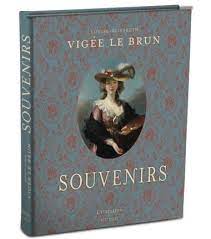
On peut en juger par le portrait au pastel que mon père a fait d'elle, et par celui que j'ai fait à l'huile beaucoup plus tard. Ce portrait est un buste ovale que je fis d'après elle : j'avais alors quinze ans et demi.
http://pastel.ovh/annexes/vigee_1.php
Eh bien, chapeau !
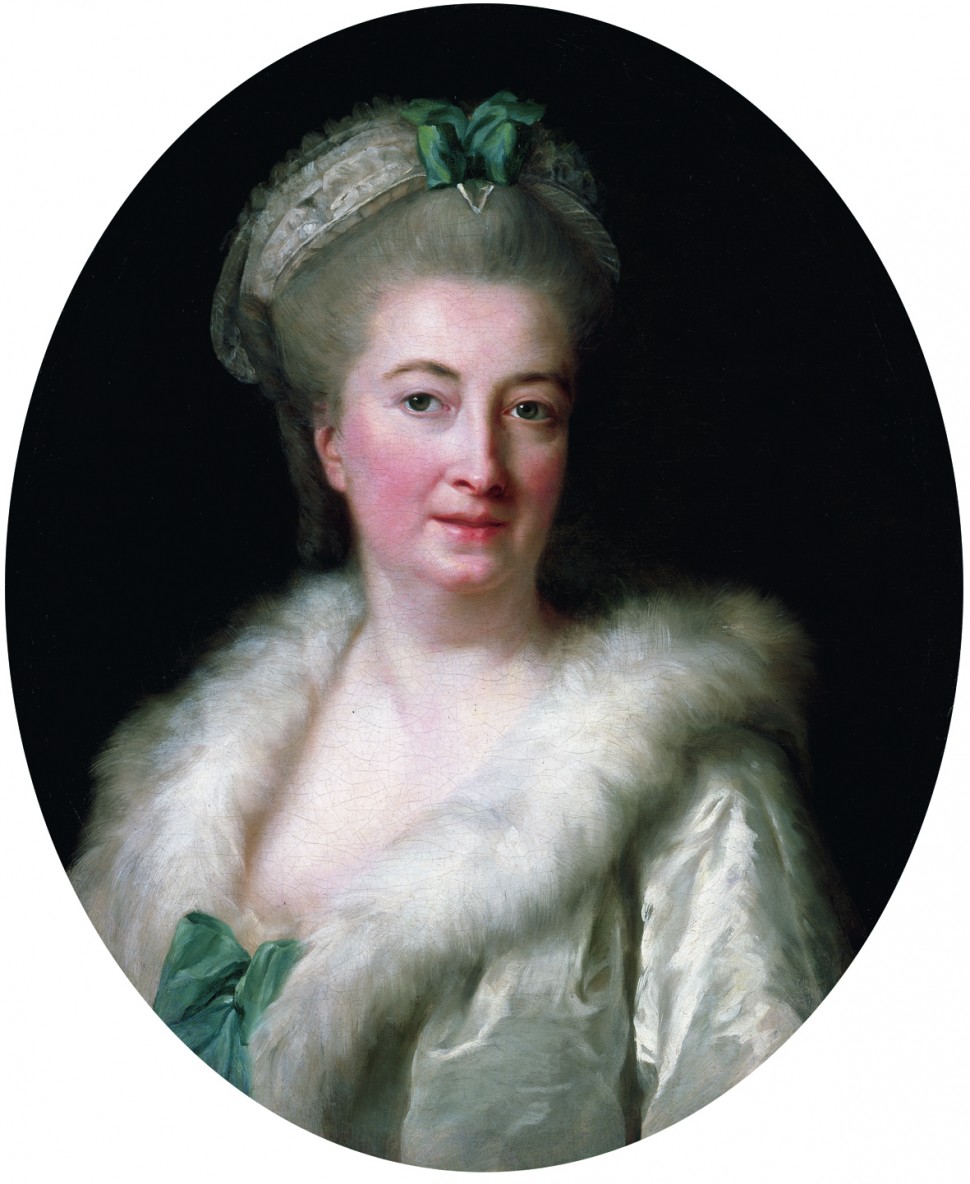

On peut en juger par le portrait au pastel que mon père a fait d'elle, et par celui que j'ai fait à l'huile beaucoup plus tard. Ce portrait est un buste ovale que je fis d'après elle : j'avais alors quinze ans et demi.
http://pastel.ovh/annexes/vigee_1.php
Eh bien, chapeau !


_________________
... demain est un autre jour .

Mme de Sabran- Messages : 55497
Date d'inscription : 21/12/2013
Localisation : l'Ouest sauvage
 Re: Galerie virtuelle des oeuvres de Mme Vigée Le Brun
Re: Galerie virtuelle des oeuvres de Mme Vigée Le Brun
Elisabeth Vigée Le Brun est encore jeune lorsqu'elle peint ce portrait, vendu aux enchères récemment :
Elisabeth Louise VIGÉE-LE BRUN Paris, 1755 - 1842
Portrait d'Adrienne Godard d'Aucour de Plancy, née Choart de Magny Saint-Loup (1754-1782)
Huile sur toile (Toile d'origine), de forme ovale
Dans son cadre d'origine estampillé 'H. LETONNE' et 'JME'
Hauteur : 64,50 Largeur : 54 cm
Provenance : Collection du modèle et de son époux Charles-François-Jean-Frédéric Godard d'Aucour de Plancy (1750-1792) ; Puis probablement par descendance à leur fils Adrien Godard d'Aucour (1778-1855) ; Puis probablement par descendance à son fils Auguste Godard d'Aucour (1815-1904) ; Puis probablement par descendance à son fils Georges Godard d'Aucour (1844-1934) ; Puis probablement par descendance à sa fille Amélie Godard d'Aucour, épouse Antoin-Ernest de Bonardi du Menil ; Puis probablement par descendance à leur Hubert-Melchior de Bonardi du Menil et à son fils Eric de Bonardi du Menil (1955-2011), château de Plancy-l'Abbaye, Aube ; Collection particulière, Paris
Expositions : 'Cent portraits pour un siècle. De la cour à la ville sous les règnes de Louis XV et Louis XVI', Versailles, musée Lambinet, 6 novembre 2019 - 1er mars 2020 et Nice, palais Lascaris, 19 mai - 22 novembre 2021, catalogue par X. Salmon, p. 188-189, n° 93
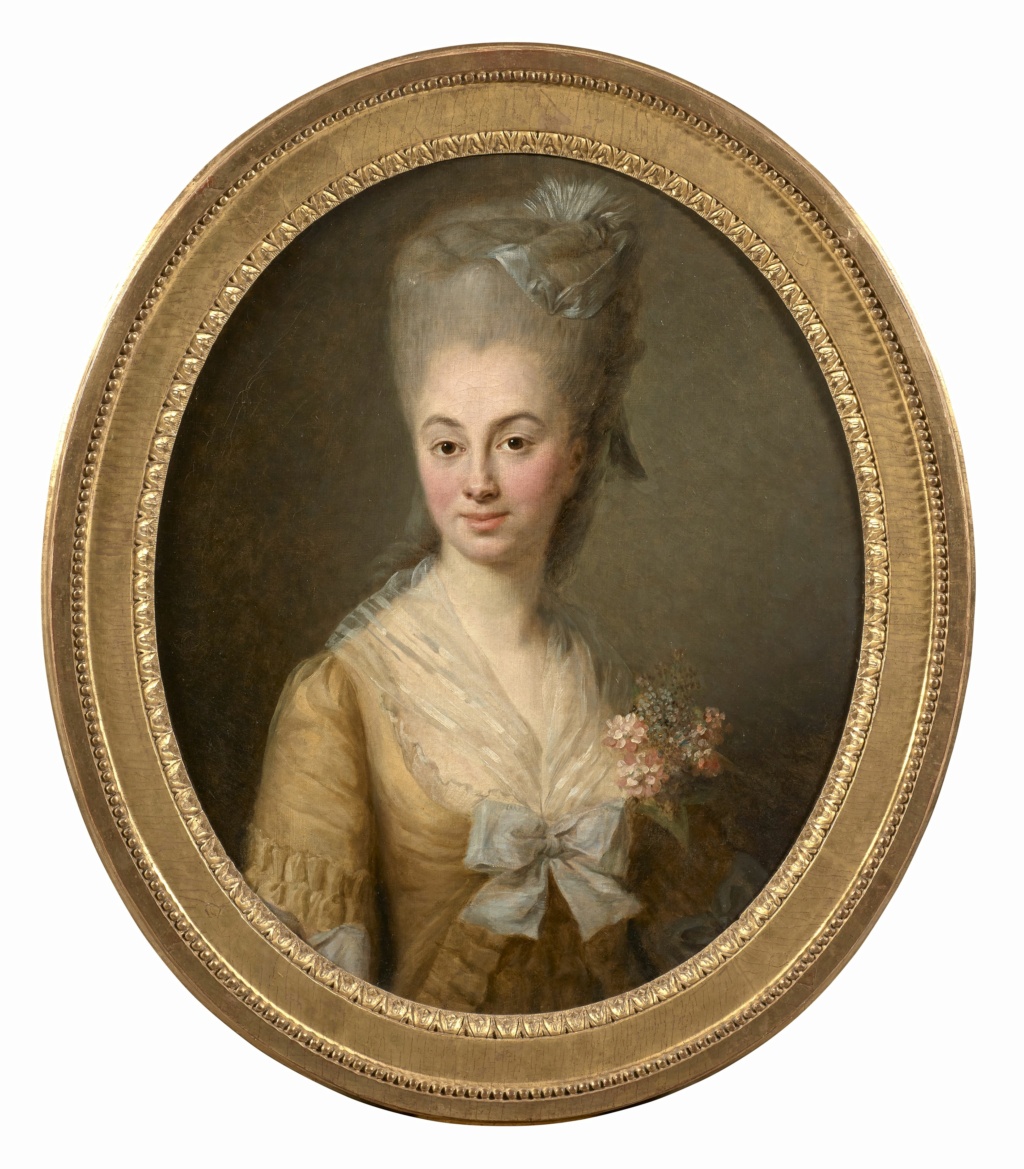
Commentaire de la maison de vente :
Longtemps conservé au château de Plancy, dans l'Aube, ce portrait d'Adrienne Godard d'Aucour de Plancy constitue une redécouverte dans l'œuvre d'Elisabeth Vigée Le Brun et présente toutes les caractéristiques de sa production précoce, au début des années 1770 : un métier rapide et une matière fluide conférant à l'ensemble un aspect vibrant, particulièrement sensible à l'arrière-plan. Il pourrait s'agir du portrait de " Madame Deplan " mentionné par l'artiste dans ses Souvenirs pour l'année 1775 (1).
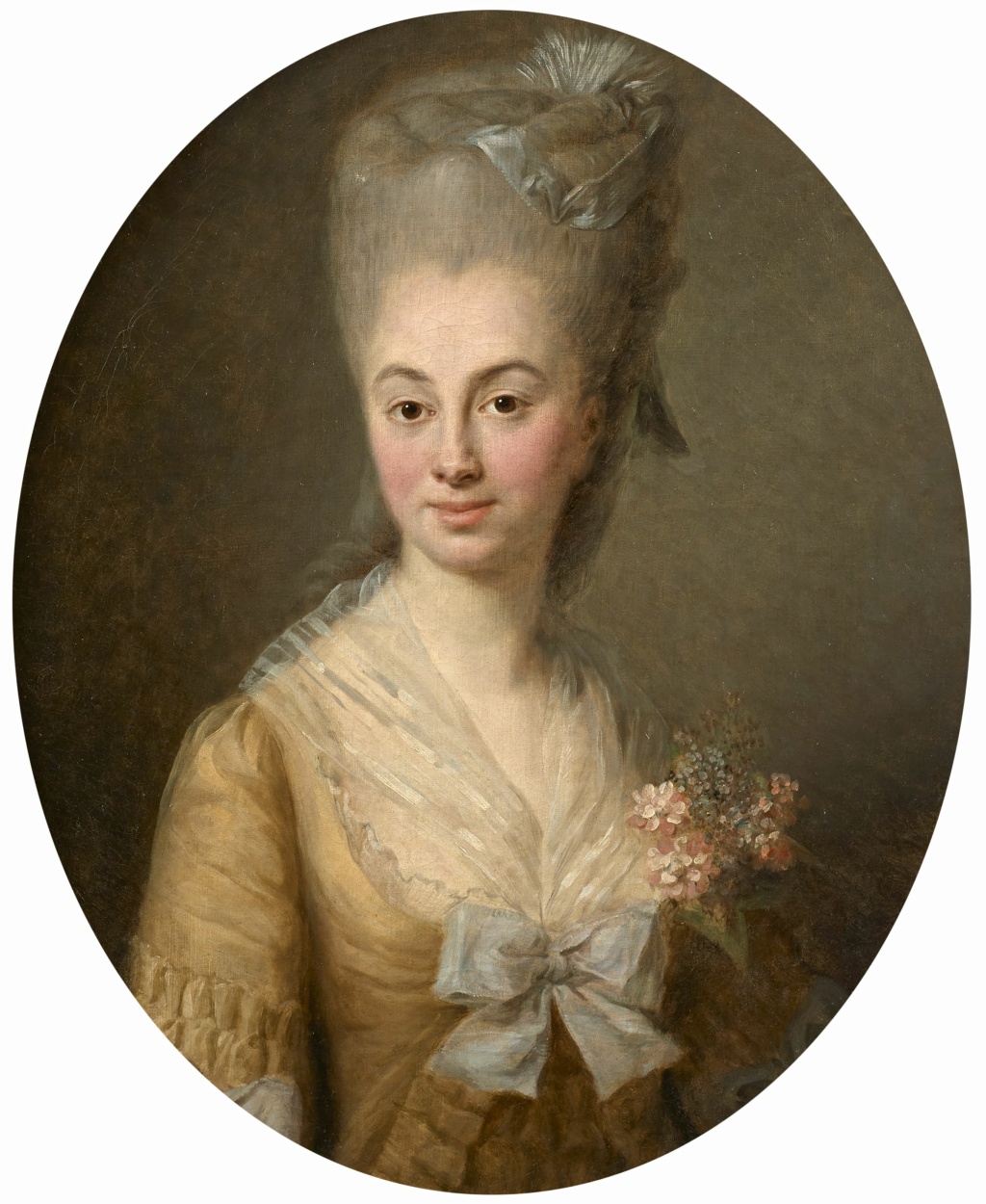
Le fond d'un coloris neutre fait ici ressortir la fraîche carnation de cette jeune femme. Elisabeth Vigée Le Brun fait preuve d'une savante harmonie de coloris, le bouquet de fleurs piqué dans le corsage venant sublimer le teint, les pommettes et les lèvres du modèle, tandis que le nœud bleu au centre de sa robe fait écho au discret ruban ornant sa haute coiffure. Un voile de gaze à la belle transparence recouvre ses épaules au-dessus d'une robe jaune.
Point d'orgue de cette toile, le regard de Madame de Plancy, peint avec une très grande acuité et une fine psychologie, qui interpelle immédiatement le spectateur. Le pouvoir de séduction de ce portrait d'une relative sobriété et d'un équilibre parfait annonce l'immense portraitiste que deviendra Elisabeth Vigée Le Brun et le succès mérité qu'elle connaîtra.
(1). Voir X. Salmon in cat. exp. Versailles, 2019, p. 188.
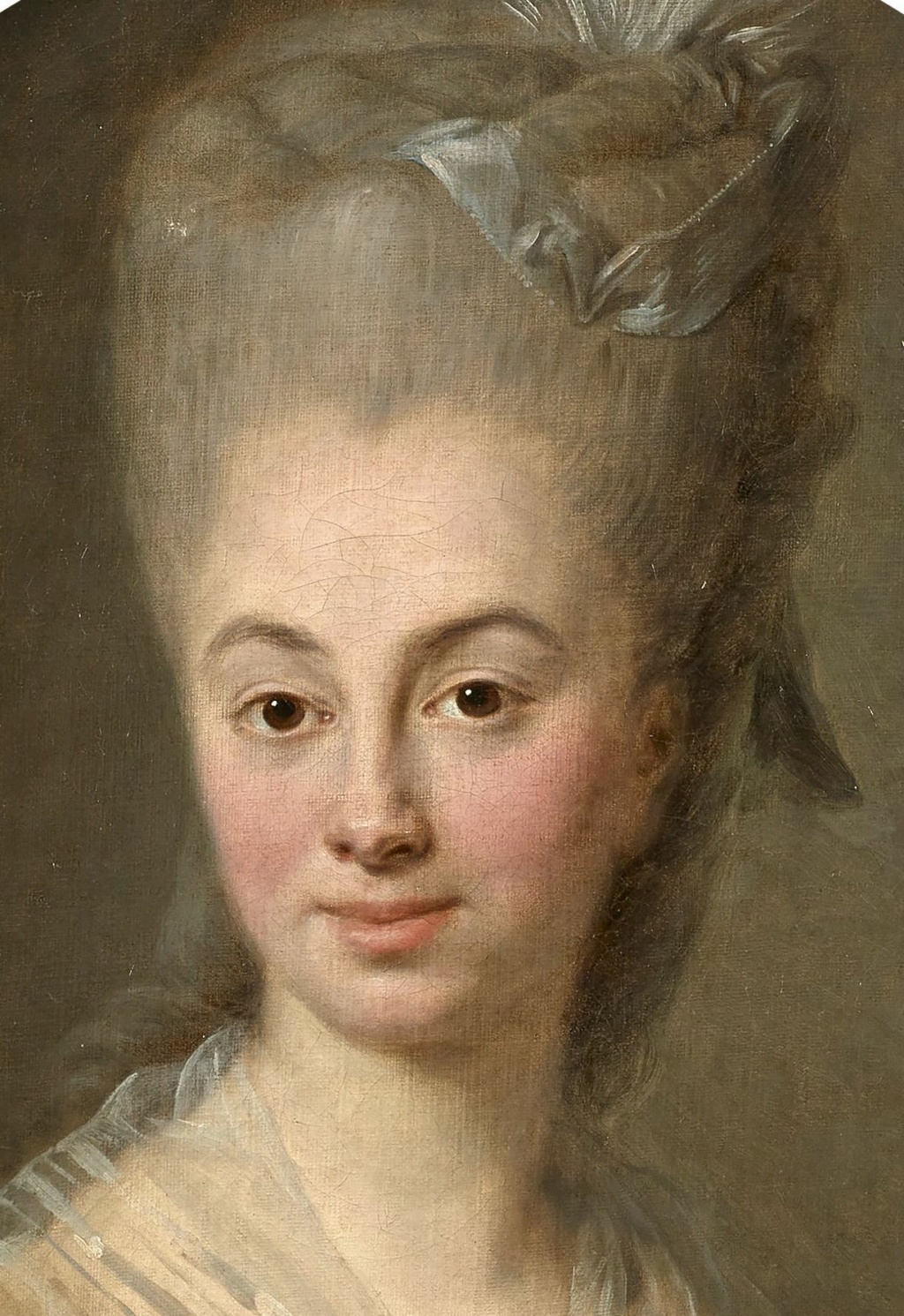
* Source et infos complémentaires : Artcurial - Vente Cent portraits pour un siècle (15 février 2022)
Elisabeth Louise VIGÉE-LE BRUN Paris, 1755 - 1842
Portrait d'Adrienne Godard d'Aucour de Plancy, née Choart de Magny Saint-Loup (1754-1782)
Huile sur toile (Toile d'origine), de forme ovale
Dans son cadre d'origine estampillé 'H. LETONNE' et 'JME'
Hauteur : 64,50 Largeur : 54 cm
Provenance : Collection du modèle et de son époux Charles-François-Jean-Frédéric Godard d'Aucour de Plancy (1750-1792) ; Puis probablement par descendance à leur fils Adrien Godard d'Aucour (1778-1855) ; Puis probablement par descendance à son fils Auguste Godard d'Aucour (1815-1904) ; Puis probablement par descendance à son fils Georges Godard d'Aucour (1844-1934) ; Puis probablement par descendance à sa fille Amélie Godard d'Aucour, épouse Antoin-Ernest de Bonardi du Menil ; Puis probablement par descendance à leur Hubert-Melchior de Bonardi du Menil et à son fils Eric de Bonardi du Menil (1955-2011), château de Plancy-l'Abbaye, Aube ; Collection particulière, Paris
Expositions : 'Cent portraits pour un siècle. De la cour à la ville sous les règnes de Louis XV et Louis XVI', Versailles, musée Lambinet, 6 novembre 2019 - 1er mars 2020 et Nice, palais Lascaris, 19 mai - 22 novembre 2021, catalogue par X. Salmon, p. 188-189, n° 93

Commentaire de la maison de vente :
Longtemps conservé au château de Plancy, dans l'Aube, ce portrait d'Adrienne Godard d'Aucour de Plancy constitue une redécouverte dans l'œuvre d'Elisabeth Vigée Le Brun et présente toutes les caractéristiques de sa production précoce, au début des années 1770 : un métier rapide et une matière fluide conférant à l'ensemble un aspect vibrant, particulièrement sensible à l'arrière-plan. Il pourrait s'agir du portrait de " Madame Deplan " mentionné par l'artiste dans ses Souvenirs pour l'année 1775 (1).

Le fond d'un coloris neutre fait ici ressortir la fraîche carnation de cette jeune femme. Elisabeth Vigée Le Brun fait preuve d'une savante harmonie de coloris, le bouquet de fleurs piqué dans le corsage venant sublimer le teint, les pommettes et les lèvres du modèle, tandis que le nœud bleu au centre de sa robe fait écho au discret ruban ornant sa haute coiffure. Un voile de gaze à la belle transparence recouvre ses épaules au-dessus d'une robe jaune.
Point d'orgue de cette toile, le regard de Madame de Plancy, peint avec une très grande acuité et une fine psychologie, qui interpelle immédiatement le spectateur. Le pouvoir de séduction de ce portrait d'une relative sobriété et d'un équilibre parfait annonce l'immense portraitiste que deviendra Elisabeth Vigée Le Brun et le succès mérité qu'elle connaîtra.
(1). Voir X. Salmon in cat. exp. Versailles, 2019, p. 188.

* Source et infos complémentaires : Artcurial - Vente Cent portraits pour un siècle (15 février 2022)

La nuit, la neige- Messages : 18132
Date d'inscription : 21/12/2013
 Re: Galerie virtuelle des oeuvres de Mme Vigée Le Brun
Re: Galerie virtuelle des oeuvres de Mme Vigée Le Brun
Au Musée des Beaux Arts de Caen, ce Portrait de jeune-femme inconnue, 1755, huile sur toile.
Cette oeuvre de L.E. Vigée est réalisée peu avant son mariage avec le marchand et restaurateur de tableaux, Jean-Baptiste Pierre Lebrun. Ses Souvenirs ( 1735 - 1737 ), qui donnent la liste de ses oeuvres, n'ont pas permis d'identifier le modèle.
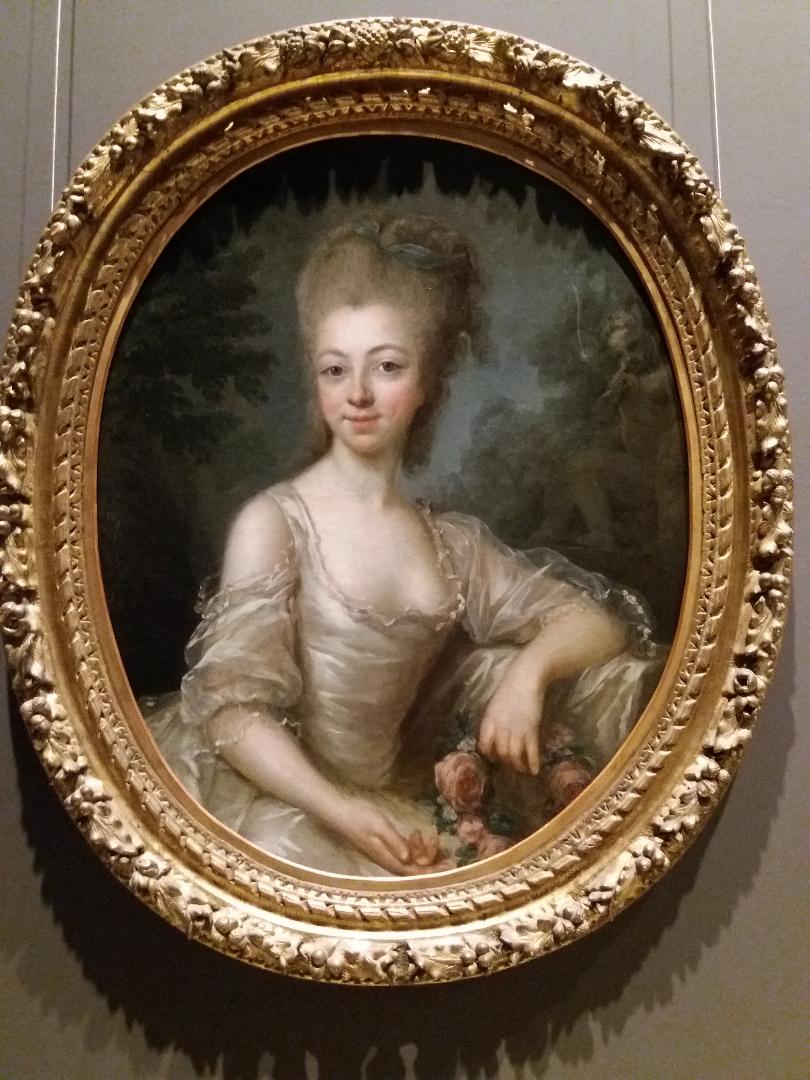
_________________
... demain est un autre jour .

Mme de Sabran- Messages : 55497
Date d'inscription : 21/12/2013
Localisation : l'Ouest sauvage
 Re: Galerie virtuelle des oeuvres de Mme Vigée Le Brun
Re: Galerie virtuelle des oeuvres de Mme Vigée Le Brun
Elle ressemble à Adrienne Godard d'Aucour de Plancy, dont EVGL a fait un autre portrait manifestement (v. le message de LNLN au-dessus du tien).

Duc d'Ostrogothie- Messages : 3227
Date d'inscription : 04/11/2017
Page 14 sur 15 •  1 ... 8 ... 13, 14, 15
1 ... 8 ... 13, 14, 15 
 Sujets similaires
Sujets similaires» Etienne Vigée, le frère d'Elisabeth Vigée Le Brun
» Les autoportraits de Mme Vigée Le Brun
» Signature d'Elisabeth Vigée Le Brun
» Docu-fiction : Le fabuleux destin d'Elisabeth Vigee Le Brun, peintre de Marie-Antoinette (2015)
» Portraits de la duchesse de Polignac
» Les autoportraits de Mme Vigée Le Brun
» Signature d'Elisabeth Vigée Le Brun
» Docu-fiction : Le fabuleux destin d'Elisabeth Vigee Le Brun, peintre de Marie-Antoinette (2015)
» Portraits de la duchesse de Polignac
LE FORUM DE MARIE-ANTOINETTE :: La France et le Monde au XVIIIe siècle :: Les Arts et l'artisanat au XVIIIe siècle :: Les arts graphiques et la sculpture
Page 14 sur 15
Permission de ce forum:
Vous ne pouvez pas répondre aux sujets dans ce forum
